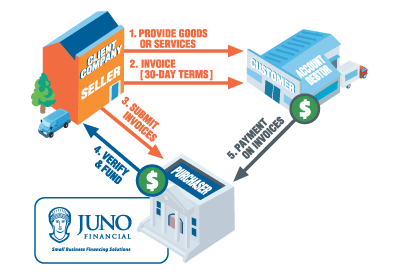

This process is sometimes used in manufacturing industries when the immediate need for raw material outstrips their available cash and ability to purchase "on account". The seller sells the receivables at a discount to the third party, the specialized financial organization (aka the factor) to obtain cash. The receivable, usually associated with an invoice for work performed or goods sold, is essentially a financial asset that gives the owner of the receivable the legal right to collect money from the debtor whose financial liability directly corresponds to the receivable asset. There are three parties directly involved: the factor who purchases the receivable, the one who sells the receivable, and the debtor who has a financial liability that requires him or her to make a payment to the owner of the invoice. The Scottish Law Commission reviewed this position and made proposals to the Scottish Ministers in 2018. Scottish law differs from that of the rest of the UK, in that notification to the account debtor is required for the assignment to take place.

In the UK, the main difference between factoring and invoice discounting is confidentiality. In the UK the arrangement is usually confidential in that the debtor is not notified of the assignment of the receivable and the seller of the receivable collects the debt on behalf of the factor. It is therefore also not considered to be borrowing in the UK. However, in some other markets, such as the UK, invoice discounting is considered to be a form of factoring, involving the "assignment of receivables", that is included in official factoring statistics. Factoring is the sale of receivables, whereas invoice discounting ("assignment of accounts receivable" in American accounting) is a borrowing that involves the use of the accounts receivable assets as collateral for the loan. In the United States, Factoring is not the same as invoice discounting (which is called an assignment of accounts receivable in American accounting – as propagated by FASB within GAAP). The Commercial Finance Association is the leading trade association of the asset-based lending and factoring industries. Accounts receivable financing is a term more accurately used to describe a form of asset based lending against accounts receivable. Factoring is commonly referred to as accounts receivable factoring, invoice factoring, and sometimes accounts receivable financing. Forfaiting is a factoring arrangement used in international trade finance by exporters who wish to sell their receivables to a forfaiter. A business will sometimes factor its receivable assets to meet its present and immediate cash needs. This would result in a difficult and expensive collections process involving both the bank and the business doing invoice financing with the bank.Factoring is a financial transaction and a type of debtor finance in which a business sells its accounts receivable (i.e., invoices) to a third party (called a factor) at a discount. Invoice financing does not eliminate all risk, though, since the customer might never pay the invoice. The lender also limits its risk by not advancing 100% of the invoice amount to the borrowing business.

Invoice financing benefits lenders because, unlike extending a line of credit, which may be unsecured and leave little recourse if the business does not repay what it borrows, invoices act as collateral for invoice financing. Invoice Financing From the Lender's Perspective Invoice financing can be structured so that the business' customer is unaware that their invoice has been financed or it can be explicitly managed by the lender.A company may use invoice financing to improve cash flow for operational needs or speed up expansion and investment plans.Invoice financing allows a business to use its unpaid invoices as collateral for financing.


 0 kommentar(er)
0 kommentar(er)
